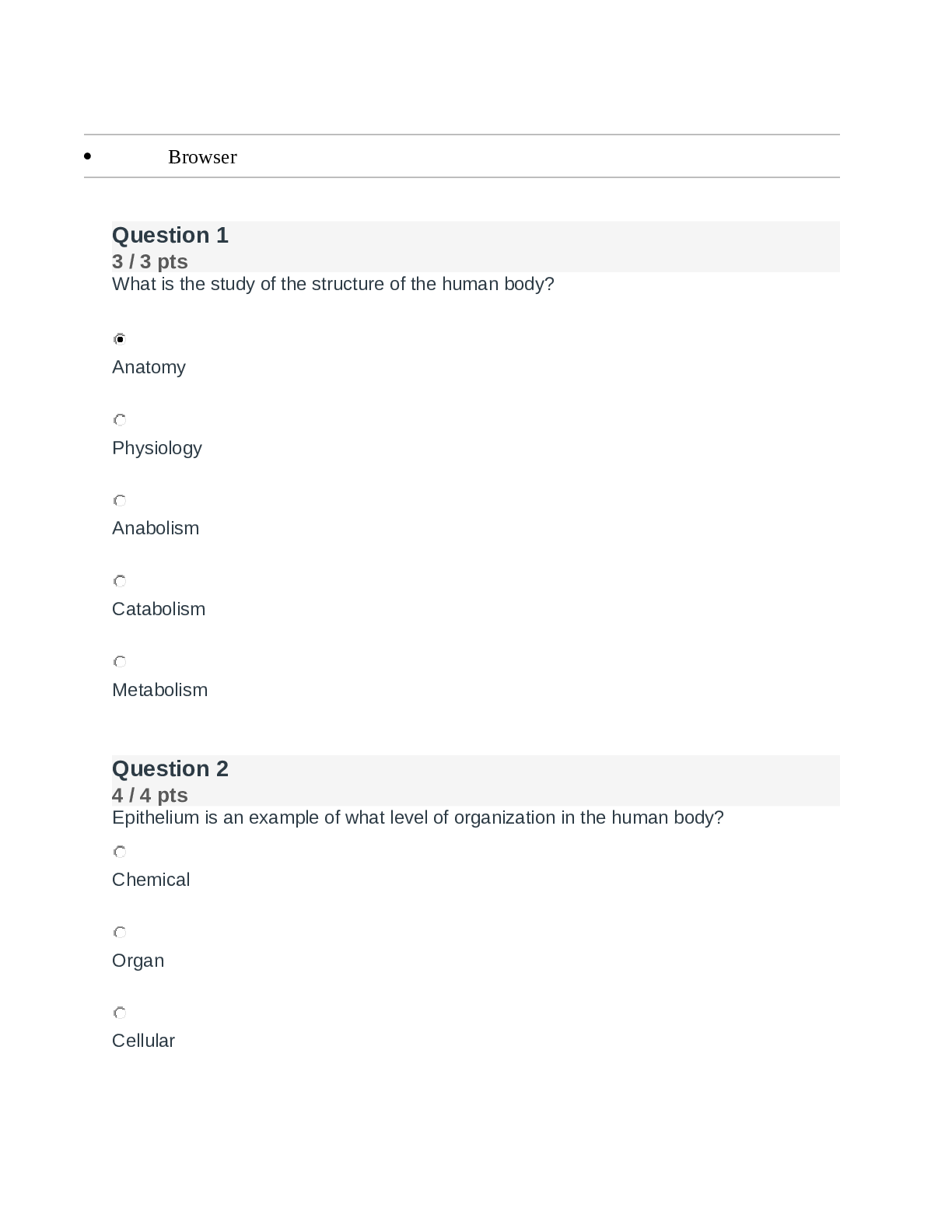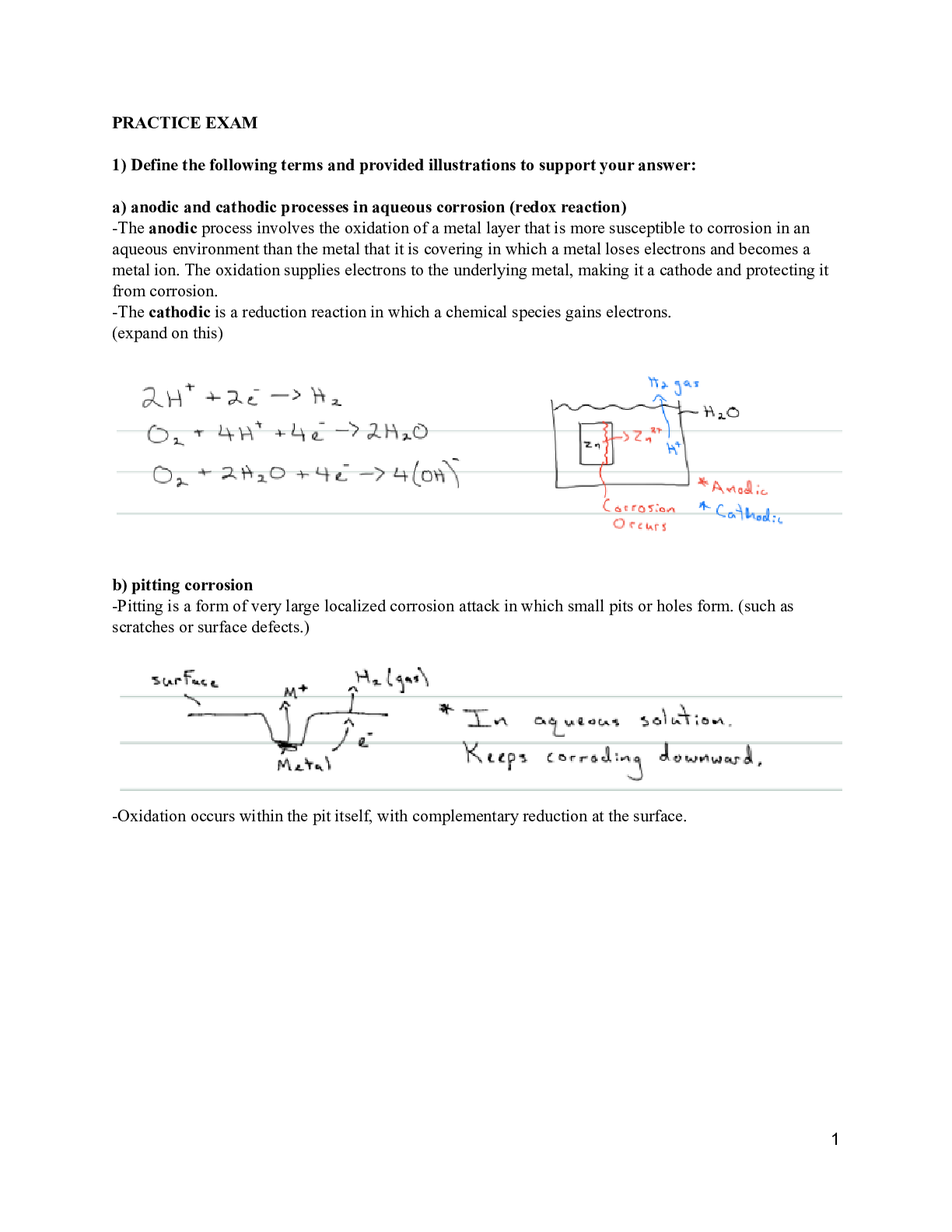*NURSING > Final Exam Review > NURS 6512 Avanced Health Assessment Final Exam Review for Week 7-11. Walden University. All Content (All)
NURS 6512 Avanced Health Assessment Final Exam Review for Week 7-11. Walden University. All Content Covered.
Document Content and Description Below
Heart, Lungs, and Peripheral Vascular (Week 7: Ch. 13, 14, & 15) • Examination techniques of the Heart, Lungs, and PV systems (See Notes) • Examination findings of arterial blood flow in infants... (339) (345) • Examination findings of the heart and lungs in a patient with illegal drug use (266) • Description: shortness of breath (orthopnea, platypnea. Tachypnea, bradypnea) (265) • Symptoms associated with intrathoracic infection • Percussion techniques when examining the lungs (273-275) • Examination findings when percussing the lungs (274) • Cardiac examination findings for a patient with rheumatic fever (330-331) • Grading of heart murmurs (311-313) Diseased valves, a common cause of murmurs, either do not open or close well. When the leaflets are thickened and the passage narrowed, • Evaluation of ECG tracings (298-299) • Examination technique for the apical pulse • Examining technique for different cardiac sounds and their names (309-311) • Varicosity findings in pregnant women (338) (345) • Examination of peripheral arteries(338-339) • Grading of pulses (340) • Examination findings of a child with Kawasaki disease (349) • Examination findings of a patient with peripheral edema (344) • Examination of ammonia in breath odor (274) • Miscellaneous o Physical Findings Associated with Common Respiratory Conditions (283-284) o The Sequence of Chest Steps: Inspection, palpation, percussion, and auscultation. Assessing Musculoskeletal Pain (Week 8: Ch. 21 & Review 4) • Diagnostic tests for patients with carpal tunnel (524) (536) • Examination techniques used for muscle and joint pain • Spinal deformities noted during examination (518-519) o Kyphosis may be observed in aging adults. Lordosis is common in patients who are obese or pregnant. A sharp angular deformity, a gibbus, is associated with a collapsed vertebra from osteoporosis. • Characteristic examination findings for Rheumatoid Arthritis (513) (538) • Orthopedic screening evaluation techniques (538-539) (585) o The two conditions that are considered absolute contraindications to sport participation are carditis and fever. Carditis (inflammation of the heart) can result in sudden death with exertion and fever is associated with an increased risk of heart-related illness. A good rule: Do not suggest that an athlete “play through” an injury or a problem. • Characteristic examination findings consistent with Osteoarthritis (538) • Characteristic examination findings consistent with Gout (536) • Miscellaneous: o Differential Diagnosis Chart: Comparison of Osteoarthritis with Rheumatoid Arthritis Assessment of Cognition and the Neurologic System (Week 9: Ch. 5 & 22) • Significance of the Denver II tool- (Pg. 72) is useful for determining whether the child is developing fine and gross motor skills, language, and personal-social skills as expected. Examination of the mental status: o Physical Appearance & Behavior- assess grooming, emotional status, and nonverbal communication (body language) The Mini-Mental State Examination (MMSE) The Mini-Cog- The importance of validation- o Common Causes of Unresponsiveness (Pg. 67) Speech and Language Skills- Emotional stability- o Expressive Language Milestones for Toddlers and Preschoolers- (Pg. 73) Pregnant Women- Prompting Memory and Cognitive Functioning Examination findings associated with Attention Deficit Hyperactivity Disorder (ADHD) • Behavior patterns of a patient with Schizophrenia, Depression, Anxiety, and Mania (Pg. 76-77). Examination findings of a patient with Diabetic Peripheral Neuropathy- (pg. 578)- a • Examination findings of all Cranial Nerves- cranial nerves are peripheral nerves that arise from the brain rather than the spinal cord. Each nerve has a motor or sensory function, and 4 cranial nerves have parasympathetic functions. o I (Olfactory)- sensory: smell reception and interpretation o II (Optic)- sensory: visual acuity and visual fields o III- (Oculomotor)- motor: raise eyelids, most extraocular movements; parasympathetic: pupillary constriction, change lens shape o IV (Trochlear)- motor: downward, inward eye movement o V (Trigeminal)- motor: jaw opening and clenching, chewing, and mastication; sensory: sensation to cornea, iris, lacrimal glands, conjunctiva, eyelids, forehead, nose, nasal, and mouth mucosa, teeth, tongue, ear, facial skin o VI (Abducens)- motor: lateral eye movement o VII (Facial)- motor: movement of facial expression muscles except jaw, close eyelids, labial speech sounds (b, m, w, & rounded vowels); sensory: taste- anterior 2/3 of tongue, sensation to pharynx; parasympathetic: secretion of salvia and tears o VIII (Acoustic)- sensory: hearing and equilibrium o IX (Glossopharyngeal)- motor: voluntary muscles for swallowing and phonation; sensory: sensation of nasopharynx, gag reflex, taste-posterior 1/3 of tongue; parasympathetic: secretion of salivary glands, carotid reflex; motor: voluntary muscles of phonation (guttural speech sounds) and swallowing o X (Vagus)- sensory: sensation behind ear & part of external ear canal; parasympathetic: secretion of digestive enzymes; peristalsis; carotid reflex; involuntary action of heart, lungs, and digestive tract o XI (Spinal accessory)- motor: turn head, shrug shoulders, some actions for phonation o XII (Hypoglossal) - motor: tongue movement for speech sound articulation (l, t, d, and n) and swallowing. • Examination techniques of all Cranial Nerves Evaluate cranial nerves one through twelve (To examine the cranial nerves, perform the following: Keep in mind that taste and smell usually are tested only if a problem is suspected. No matter which nerves you test, their function should be intact. • Deep Tendon Reflex evaluation- (pg. 564) With the patient relaxed and seated or lying down, test five deep tendon reflexes. When using a reflex hammer, remember to tap briskly, but not too forcefully. And be sure to score each reflex from zero (for no response) to four-plus (for a hyperactive response with clonus). • Examination technique and findings for nuchal rigidity- (pg. 565-566) a stiff neck or nuchal rigidity, is a sign that may be associated with meningitis and intracranial hemorrhage. Place your patient in a supine position, slip your hand under the head and raise it, flexing the neck. Try to make the patient’s chin touch the sternum, but do not force it. Placing your hand under the shoulder when the patient is supine and raising the shoulders slightly will help relax the neck, making the determination of true stiffness more accurate. Pain and a resistance to neck motion are associated with nuchal rigidity (other causes could be due to painful swollen lymph nodes or superficial trauma can cause neck resistance). o Indirect cranial nerve evaluation in newborns and infants- (pg. 567-569) o Abnormalities: Disorders of the neurologic system (pg. 573-580) Assessing the Genitalia and Rectum Case Study (Week 10: Ch. 16, 18, 19, & 20) • Significance of Montgomery tubercles • Examination findings of breast changes during menopausal • Examination findings consistent with breast cancer in females • Proper technique for using a speculum during the vaginal exam (430-431) • Proper technique for the bimanual examination • Proper technique for examining the male genitalia, including the prostate • Risk factors for testicular and Penile cancer (470) • Normal vs abnormal bowel findings in newborns • Risk factors for colorectal cancer (498) • Risk Factors: overweight/obese, physical inactivity, certain diets (red meats/processed meats), smoking, heavy alcohol use, old age after 50, history of colorectal polyps, history of IBS, family • Examination findings consistent with Benign Prostate Hypertrophy (498) • Examination findings consistent with Prostate Cancer • Examination position when assessing anal sphincter tone • Characteristics of menopausal disorder • Characteristics of Pelvic Inflammatory Disease (462) • Characteristics of Hydrocele, Epididymitis, Epispadias, and Hypospadias • Epididymitis- acute painful swelling without discoloration and a thickened or • Epispadias- is a rare type of malformation of the penis in which the urethra • Cancer of the Male Genitalia (Penile/Testicular) (470) • Miscellaneous o Vaginal Discharges and Infections (Female Genitalia) (457) o ** Unexplained Fever: the search for an unexplained fever should always include the rectal examination- a rectal condition or prostatitis may be the cause. The Ethics Behind Assessment (Week 11: Ch. 23 24) [Review: Ch. 16 & 18] • Ethical considerations when completing adolescent sports physicals with no injuries vs adolescents with previous injuries • Diagnostics tests used to evaluate sports injuries • Examination of children with heart murmurs when conducting a sports physical (583) o Heart murmur (auscultation should be performed in both supine and standing positions, or with Valsalva maneuver, to identify murmurs of dynamic left ventricular outflow obstruction). • Ethical considerations to be made as Advanced Practice Registered Nurse • Miscellaneous o Hypertension in the pediatric adult (pg. 582) o Atlantoaxial Instability (pg. 582) • [Show More]
Last updated: 9 months ago
Preview 1 out of 28 pages
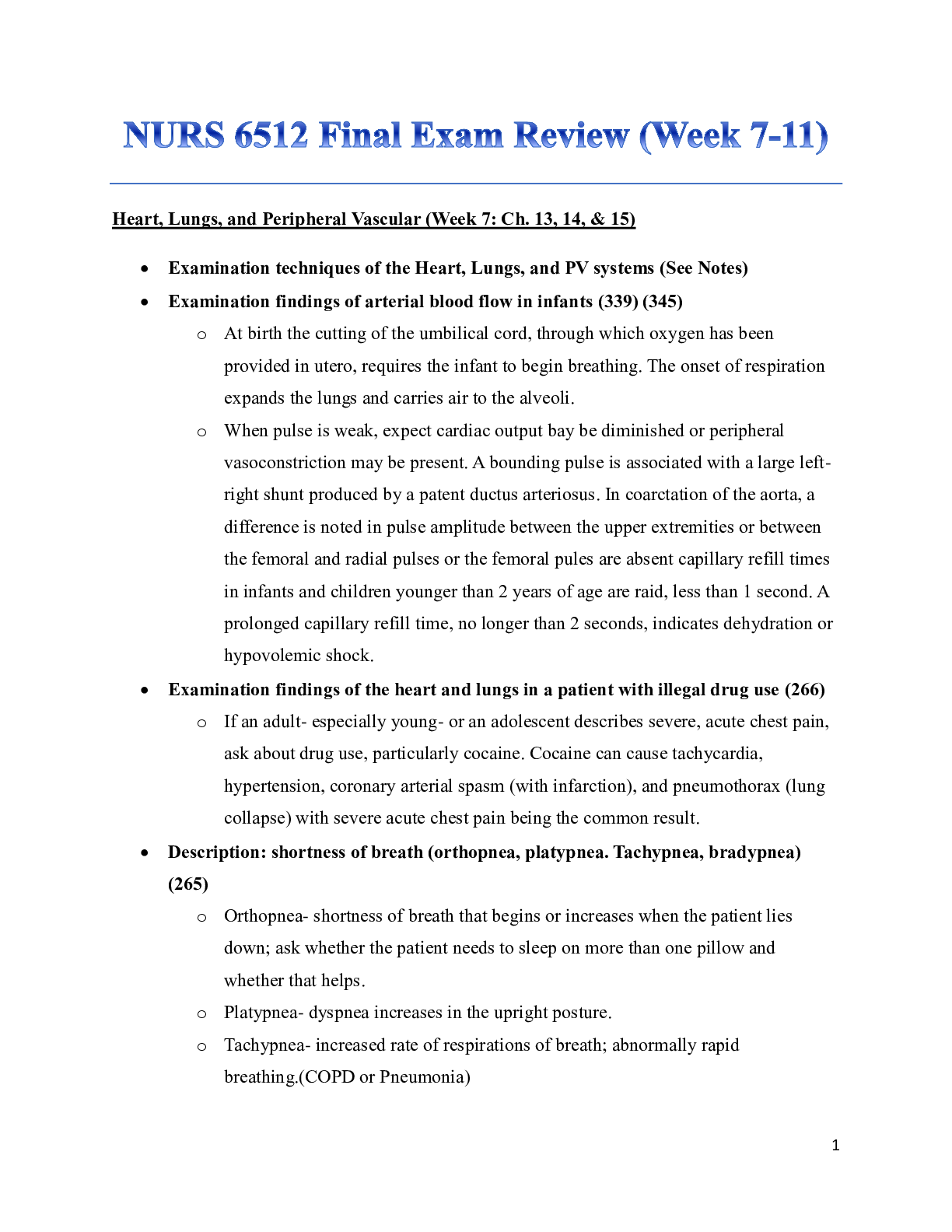
Reviews( 0 )
Document information
Connected school, study & course
About the document
Uploaded On
Mar 09, 2020
Number of pages
28
Written in
Additional information
This document has been written for:
Uploaded
Mar 09, 2020
Downloads
5
Views
331


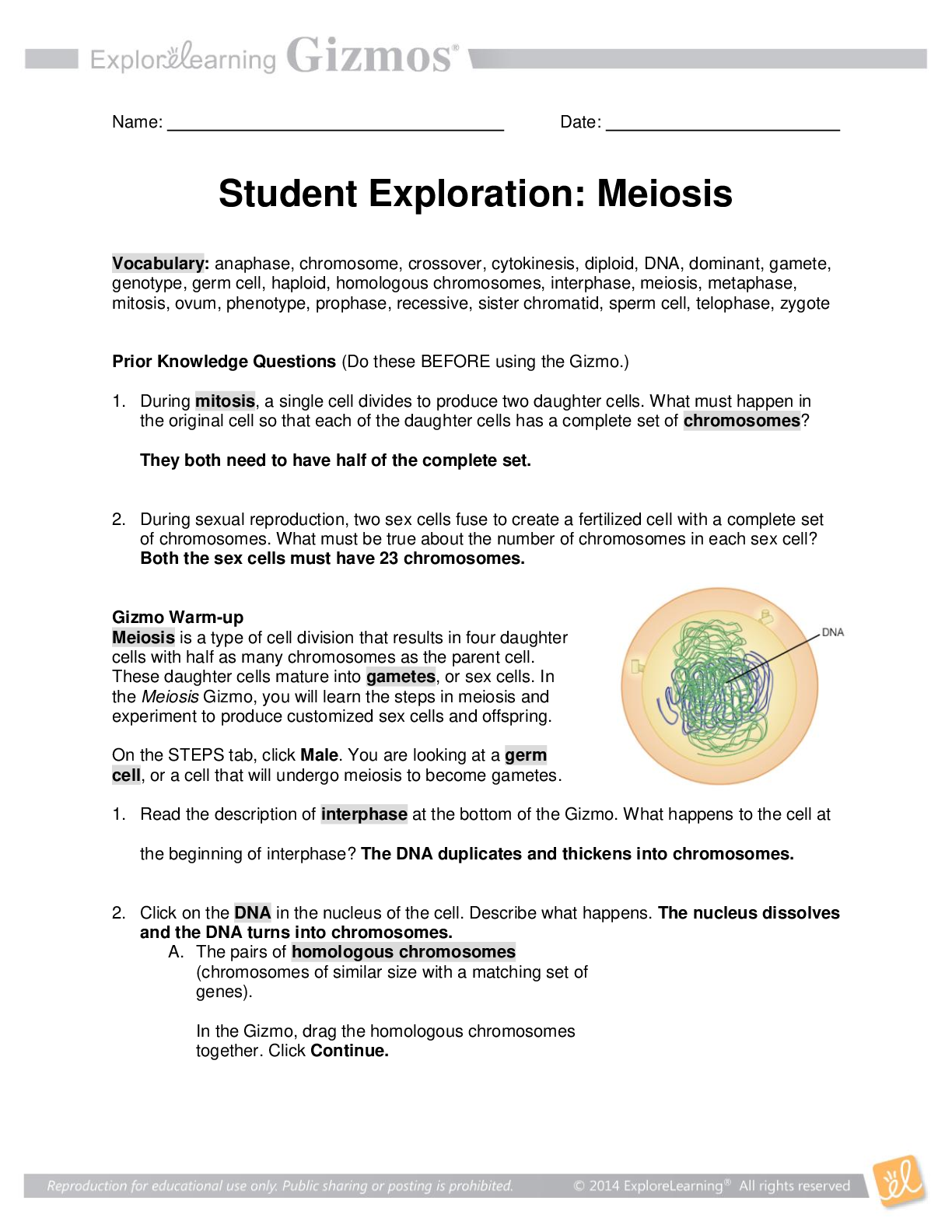


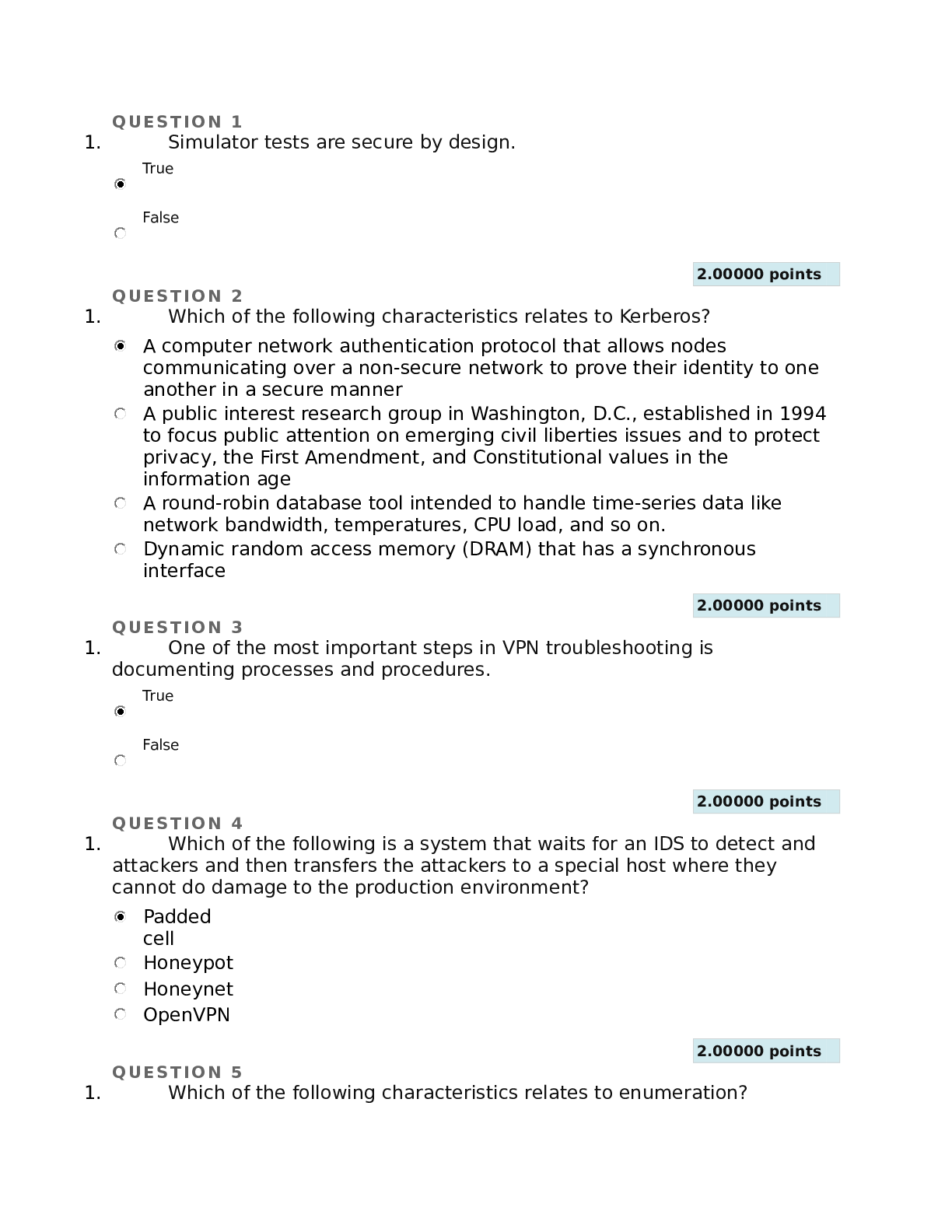



.png)

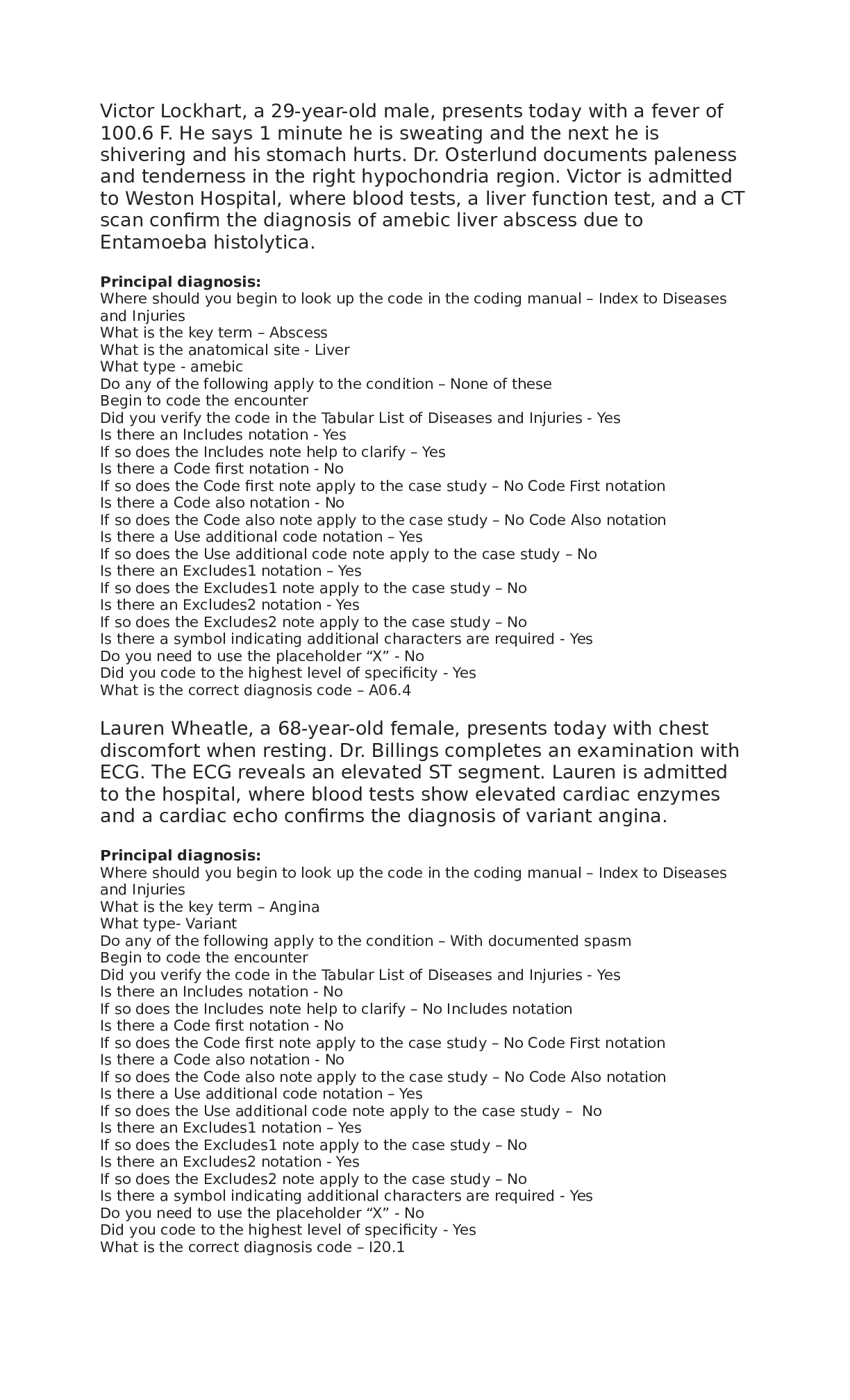


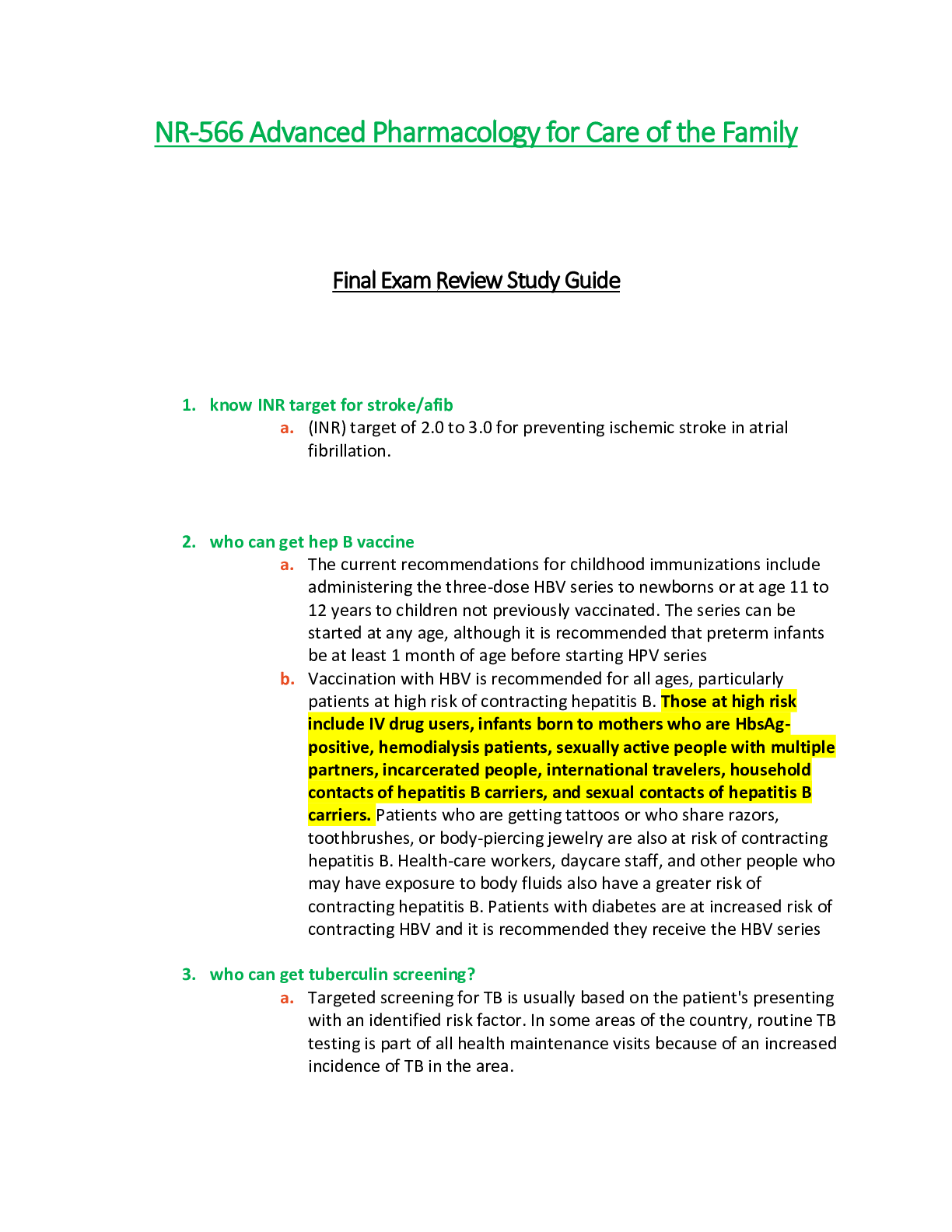
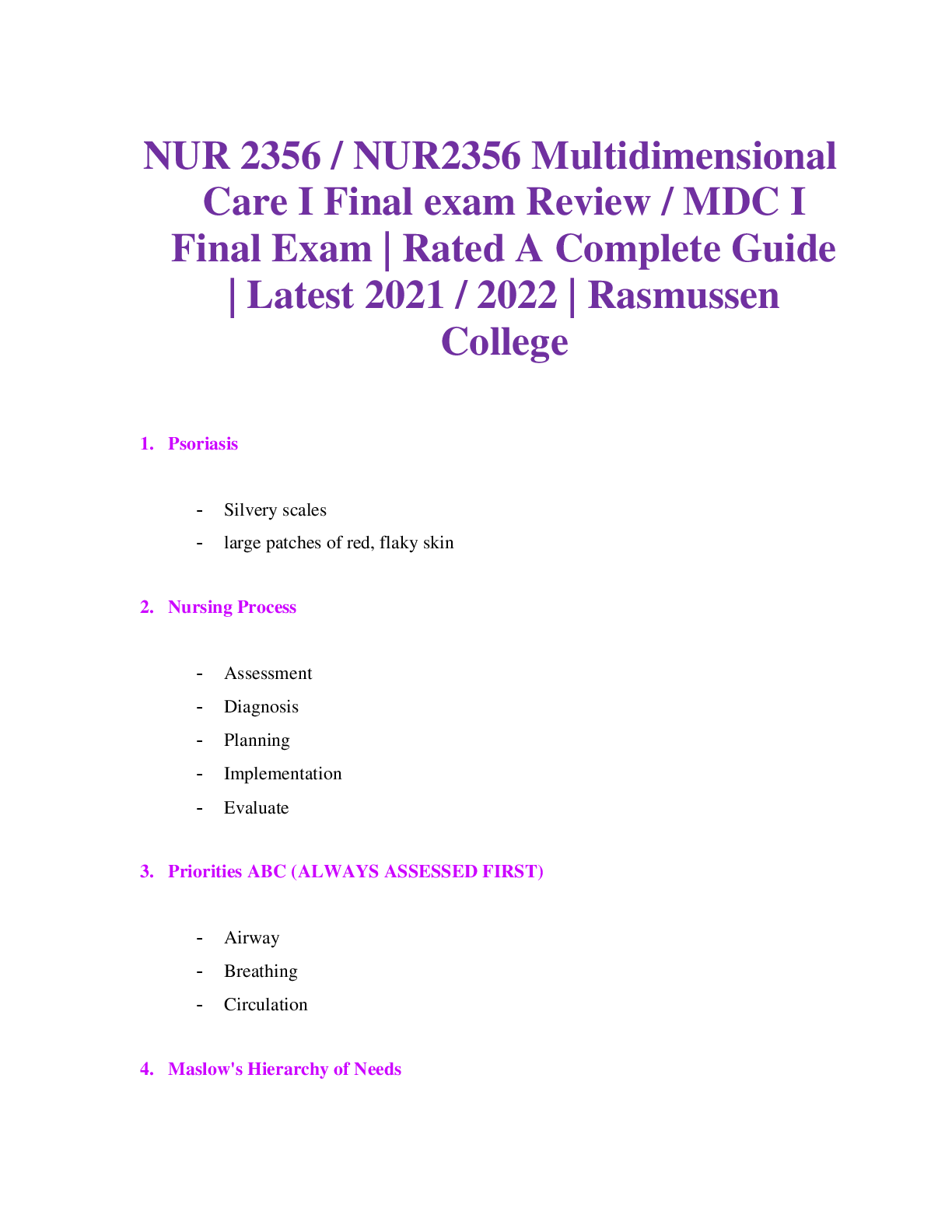
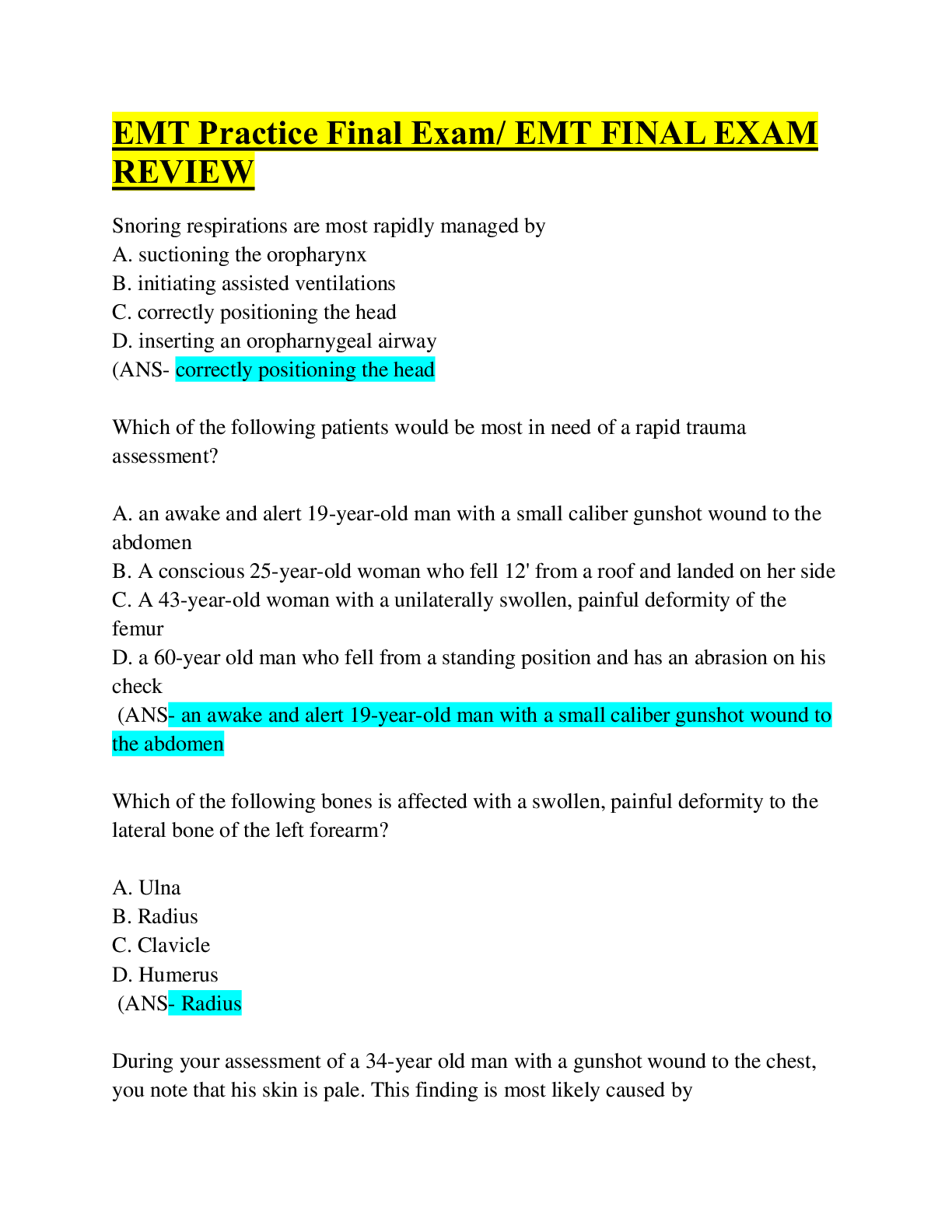

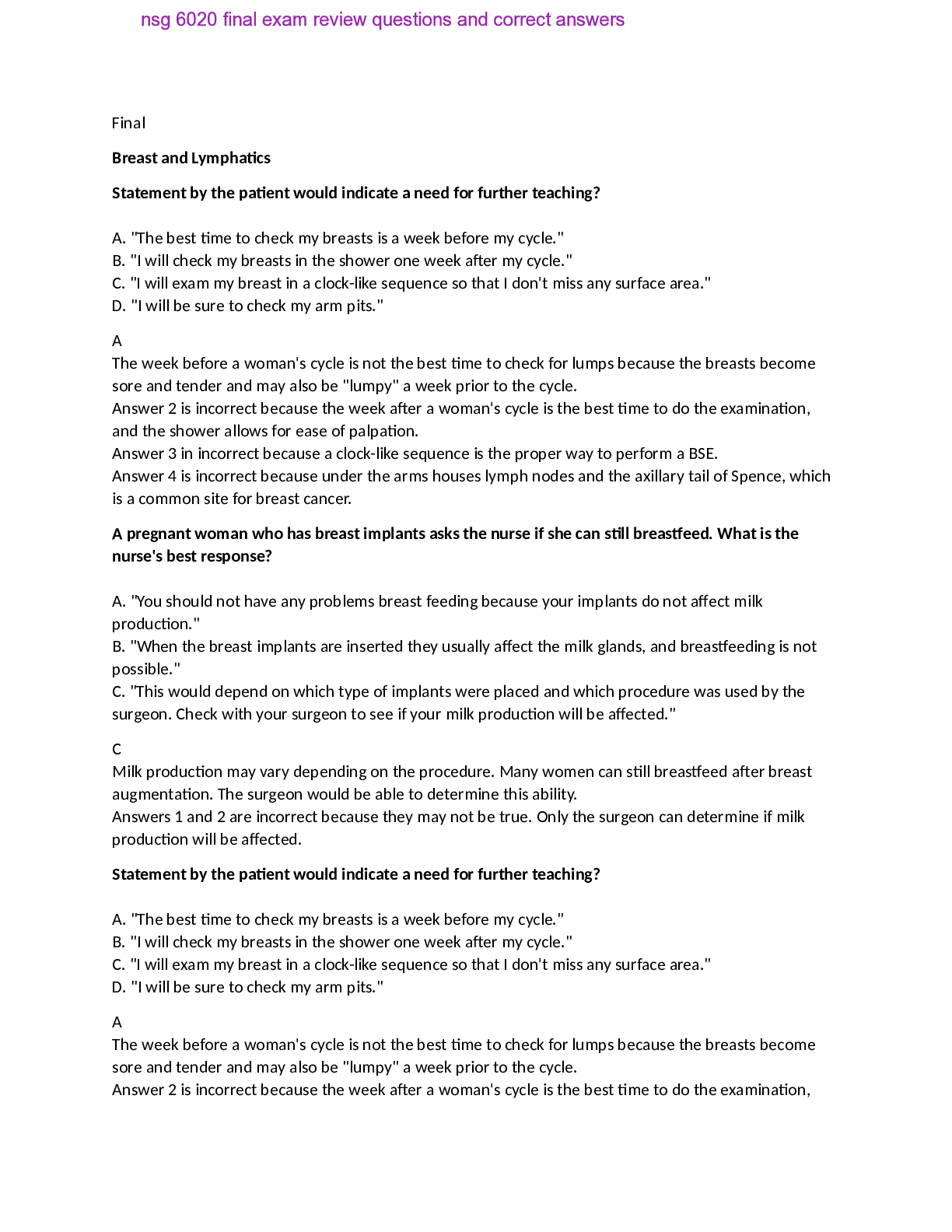

.png)
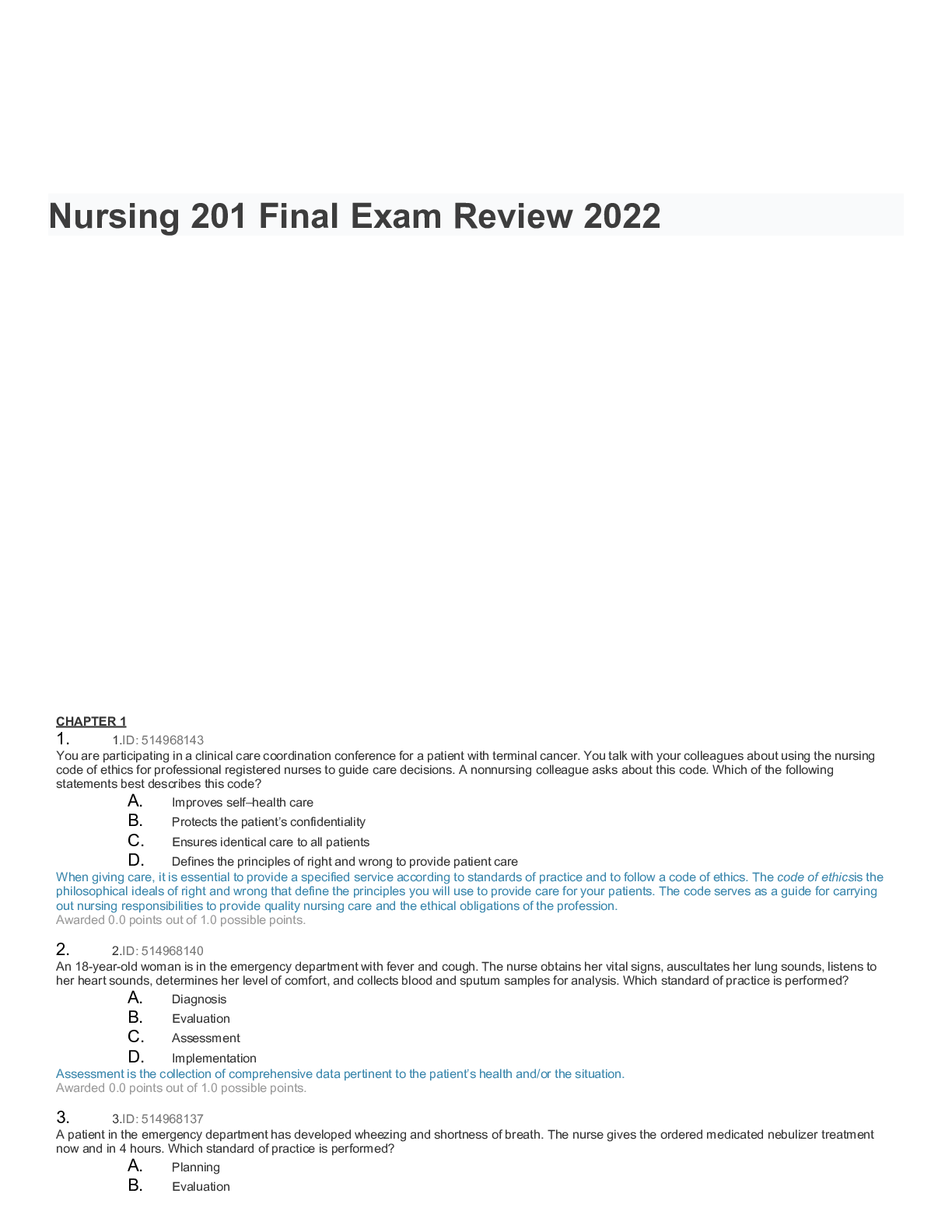
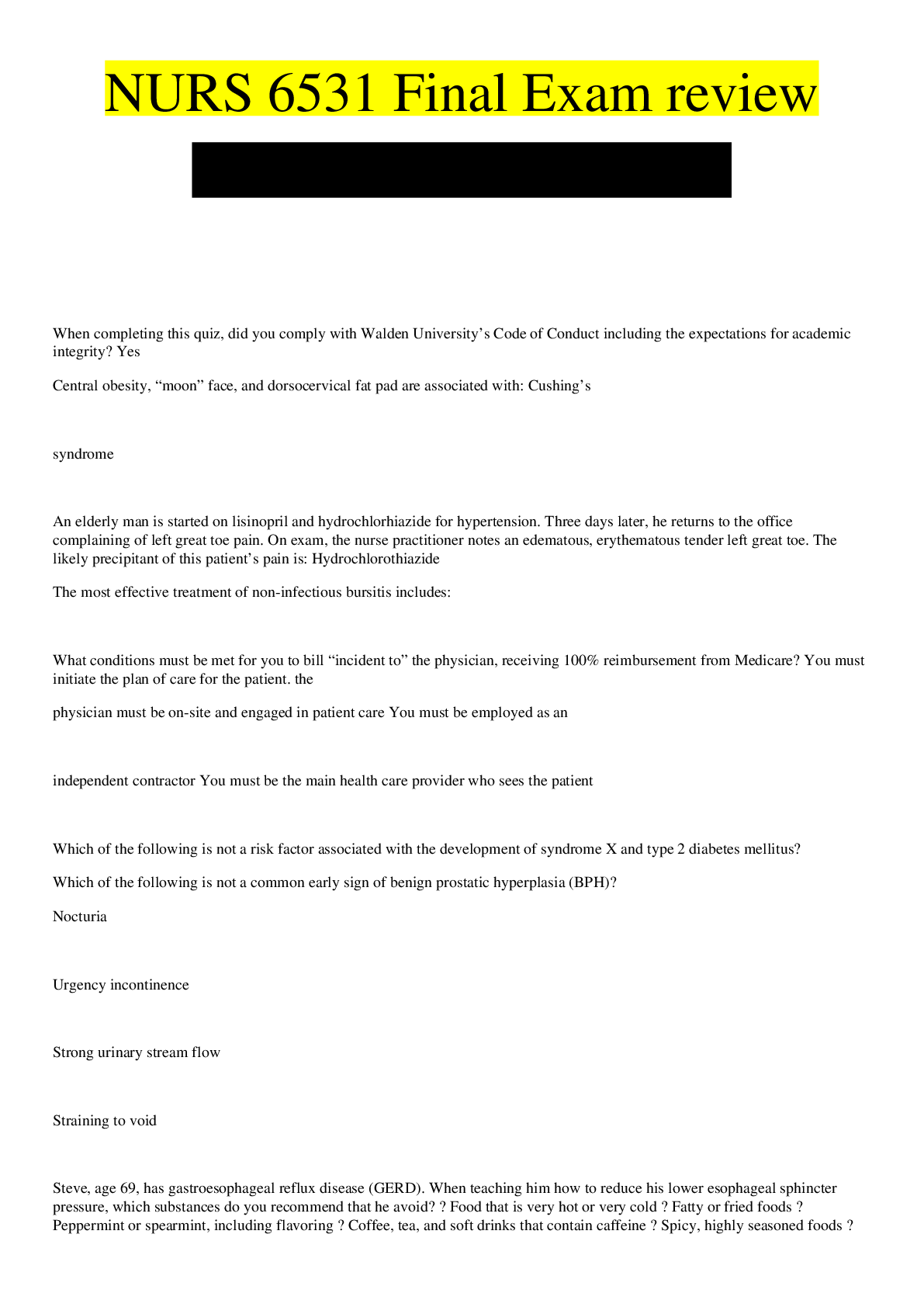
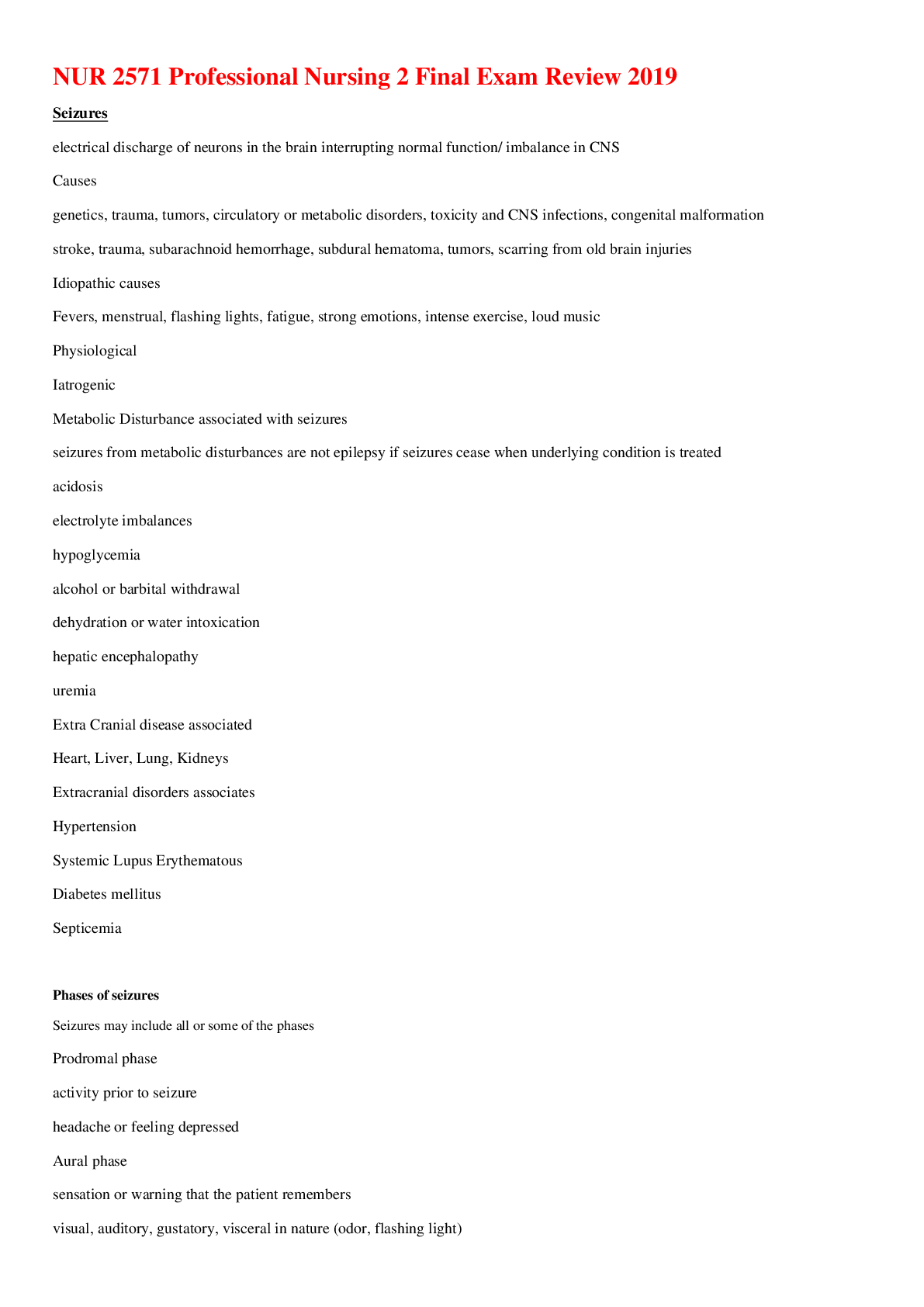

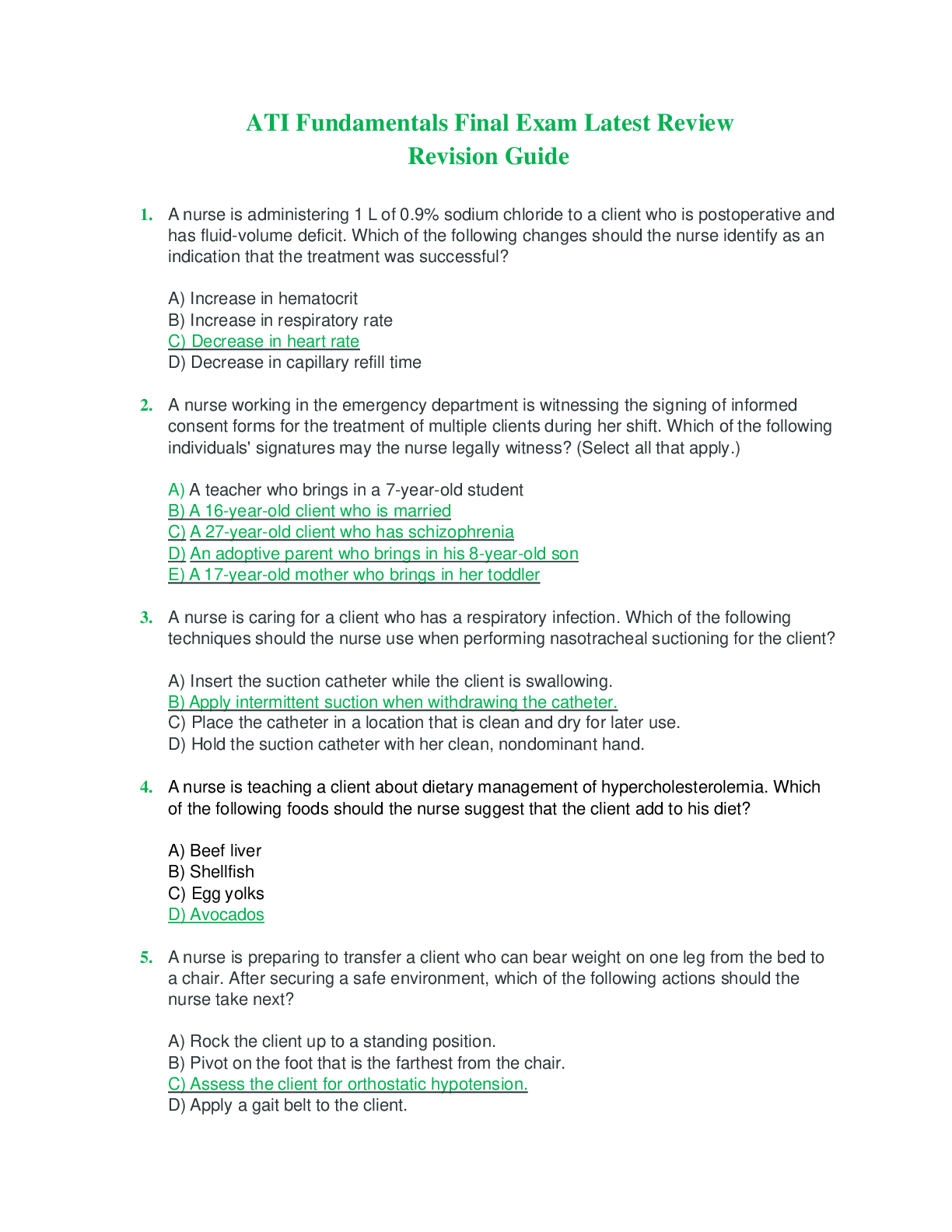
.png)
 (1).png)
 (1).png)
